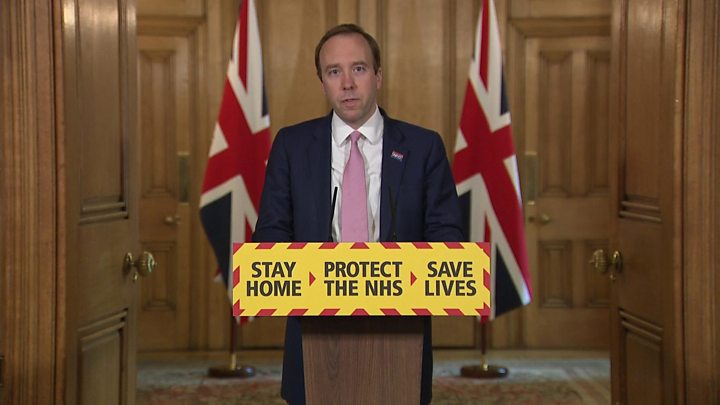
Media playback is unsupported on your device
The UK provided more than 122,000 coronavirus tests on the last day of April, passing the government's target, Health Secretary Matt Hancock said.
Mr Hancock said the target of 100,000 tests per day was an "audacious goal", but testing was necessary "for getting Britain back on her feet".
The figure includes home test kits counted when they were dispatched, which may not yet have been processed.
Mr Hancock set the goal on 2 April, when the UK was on 10,000 tests a day.
Some 27,510 people have now died in UK hospitals, care homes and the wider community after testing positive for coronavirus.
Of the 122,347 tests provided in the 24 hours up to Friday morning, the number of people tested was fewer - at just over 70,000. This could be down to some people having to be tested more than once.
The total figure includes 27,497 testing kits which were delivered to people's homes - but these may not have been actually completed or returned to a lab.
A further 12,872 tests were sent out to so-called "satellite centres" such as hospitals and NHS sites.
Labour's shadow health secretary Jonathan Ashworth suggested the government had been misleading by counting tests that had been mailed out to people, rather than completed and sent back.
"Tonight's headline figure shouldn't count tests that hadn't been used, or indeed, might never be used as a completed test," he said.
At the daily Downing Street briefing, Prof John Newton - a scientist advising the government on testing - said any tests that are done "within the control of the programme, which is the great majority, are counted when the tests are undertaken in our laboratories".
But he said any test that goes "outside the control of the programme" are counted when they leave the programme.
"So that's the tests that are mailed out to people at home and the test that's gone out on the satellite."
He added: "That's the way they are counted, have always been counted, and the way we were advised to count them by officials."
The headline figures certainly look impressive - 122,000 tests in a day. Just a week ago around 25,000 were being recorded and a month ago it stood at 10,000.
It is testament to the hard work that has been done behind the scenes by a partnership of government, scientists and the private sector - with a helping hand from the military.
But has the government been a little creative with its counting? It has included home-testing kits sent out to individuals as well as the satellite kits - these are batches of tests sent out to care homes and other settings where there are lots of people who need testing.
Some, no doubt, will never be returned.
A week ago these made little difference to the figures - only a few thousand a day were being sent out. But now they account for around a third of the tests.
In his opening remarks, the health secretary suggested the government's 100,000 target had had a "galvanising effect".
He said the testing capacity built since then would "help every single person in this country", and would "help us to unlock the lockdown".
Mr Hancock said the government's "next mission" was the roll-out of its test, track and trace operation.
"By mid-May, we will have an initial 18,000 contact tracers in place," he said.
"That work is under way as we speak and if it needs to be bigger, we will scale it as required.
"The combination of contact tracers and new technology, through our new Covid-19 NHS app, will help tell us where the virus is spreading and help everyone to control new infections."
Mr Hancock added that the next phase would allow the government "to reassert, as much as is safely possible, the liberty of us all".
How testing was expanded
The Department of Health established a testing network, including three "mega labs" to test samples, almost 50 drive-through centres, a home-testing service and mobile testing units, as part of the drive to achieve the government's target.
Meanwhile, Mr Hancock also expanded the list of people eligible for testing throughout the month.
At first, across the UK, the focus was on testing the sickest patients in hospitals, followed by health, care and emergency services staff.
As of last week, other essential workers and their families in England became eligible for testing, if they showed symptoms.
Testing was further expanded earlier this week to millions more people, with symptoms including over-65s, those who have to leave home to work, and people living with someone in these groups.
https://news.google.com/__i/rss/rd/articles/CBMiJmh0dHBzOi8vd3d3LmJiYy5jby51ay9uZXdzL3VrLTUyNTA4ODM20gEqaHR0cHM6Ly93d3cuYmJjLmNvLnVrL25ld3MvYW1wL3VrLTUyNTA4ODM2?oc=5
2020-05-01 16:30:42Z
52780756970704
Tidak ada komentar:
Posting Komentar